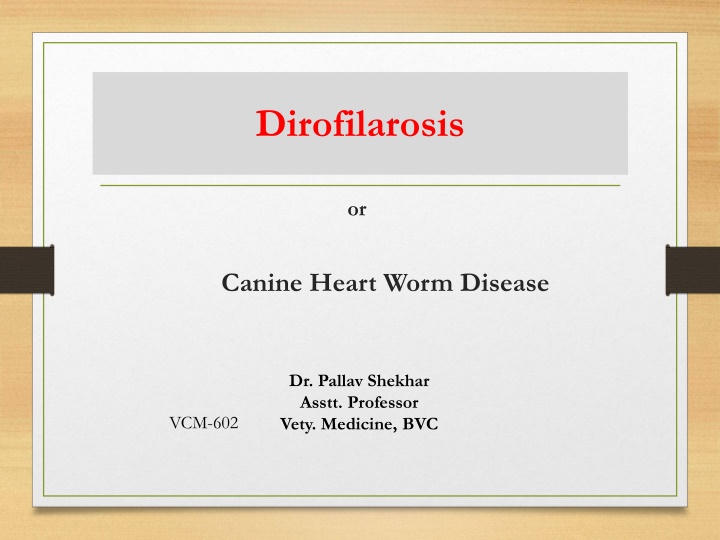Dirofilarosis
Canine heartworm disease, caused by Dirofilaria immitis, affects dogs, cats, foxes, and wolves, leading to right-sided heart failure. Learn about the epidemiology, transmission, and pathogenesis of this disease, including the role of mosquitoes in its spread. Discover how Wolbachia pipiens, an endosymbiotic bacteria, plays a key role in the disease cycle.
Download Presentation

Please find below an Image/Link to download the presentation.
The content on the website is provided AS IS for your information and personal use only. It may not be sold, licensed, or shared on other websites without obtaining consent from the author.If you encounter any issues during the download, it is possible that the publisher has removed the file from their server.
You are allowed to download the files provided on this website for personal or commercial use, subject to the condition that they are used lawfully. All files are the property of their respective owners.
The content on the website is provided AS IS for your information and personal use only. It may not be sold, licensed, or shared on other websites without obtaining consent from the author.
E N D
Presentation Transcript
Dirofilarosis or Canine Heart Worm Disease Dr. Pallav Shekhar Asstt. Professor Vety. Medicine, BVC VCM-602
Introduction It is disease of dog, cats, foxes and wolves Etiology: Dirofilaria immitis It produces Rt. Sided heart failure leading to venous congestion, ascites and hydrothorax. The disease can occur in any age group of dogs. Found in Rt . Ventricle and pulmonary artery.
Epidemiology Heart worm was first time described in dogs in Italy in 1626. Nine species of Filarial nematodes infect dog world wide. Heart is disease of canids bit it is found in more than 30 species of animals including human and birds. 70 species of mosquitoes serve as Intermediate host
Mosquitoes serves as intermediate host: Aedes, Anopheles and Culex are common vectors. Reported in temperate, semitropical and tropical climate. More in dog in comparison to cat and ferrets. Outdoor dogs and cats are more susceptible. More infection in medium to large size dogs in age group of 3-8 years.
Infected mosquitoes are capable of transmitting HW to Human but no report of Clinical Disease. Coin lesion visible in thoracic radiograph and mimic lung cancer.
Transmission Reservoir host Competent mosquito Favorable climatic conditions 27 C and 80 % humidity.
70 species of mosquitoes, in which 22 species of mosquitoes are proven vectors. Unprotected dogs, feral dogs and wild canids serves as reservoir hosts. Wolves, Coyotes, Foxes, Seals, Sea lions and Raccoons
Pathogenesis or L/C-Indirect L1 larvae (microfilaria) Rt. Lay eggs Adult worm Atrium/Rt.Ventricle/Pul. Artery Circulation Peripheral L1 in mosquito Mosquito suck blood L3 larvae L3 through S/c or I/M Infective Mosquito Another dog Rt. Side of the heart and development into adult in 1-2 months Enters in blood
Wolbachia pipiens It is an endosymbiotic bacteria which lives intracellularly in Dirofilaria immitis. Plays role in pathogenesis Endotoxin production. Responsible for maturation, reproduction and infectivity of heart worm. Surface Protein i.e WSP -- (IgG) - Glomeulonephritis.
Pathogenesis Larvae in sub cutaneous tissue cause dermatitis and itching. Adult worm leaves for 3-5 years and microfilariae for 2 years in dogs. Adult worm in heart cause impairment of blood flow from Rt. Auricle to Rt. Ventricle and to pulmonary artery to lung. Back flow of blood Ascites, Hydrothorax and Anasarca
Clinical Signs Early inf. Mild disease Moderate dis Ab. Lung sound Severe disease Class 3 Signs RSCHF Caval Syndrome Class 4 Sudden onset of lethargy Class 1 No signs Class 1 Cough Class 2 Cough, Exercise intol., Hemoglobinemia and hemoglobinuria
Clinical findings Sudden death due to intra vascular hemorrhage Chronic coughing that increased after exercise Pot belly appearance Rapid breathing
Diagnosis Microfilaria in Blood Antigen test Thoracic Radiography: Inverted D shaped cardiac Sillhoute Echocardiography
Treatment 1. Melarsomine- Adult worm Doxycycline 2. Moxidectin- Microfilariae Ivermectin Doxycycline Milbemycin
Prevention Ivermectin Milbemycin Selamectin Moxidectin

